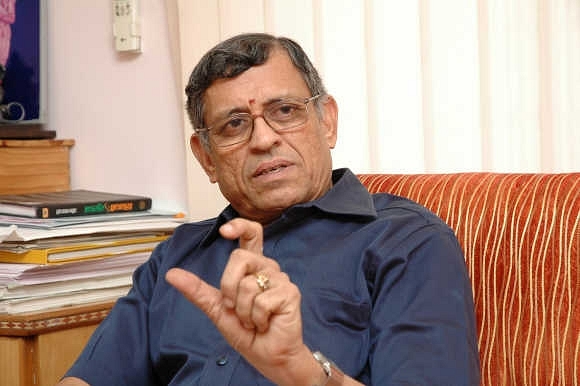
S Gurumurthy Explains Why Demonetisation Was Needed And How It Will Help The India Growth Story
S Gurumurthy, well-known political and economic analyst from Chennai, has been a long time crusader against black money. He has been writing about its evils and suggesting ways to tackle the issue for more than a decade now. He spoke to Doordarshan for more than 30 minutes about the need for demonetisation, and how it affects the Indian economy.
Excerpts:
Why Demonetisation Was Needed?
This move was long overdue. The growth of cash economy in proportion to the gross domestic product (GDP) – was less than 10 per percent until 2001, now it is almost 12 per cent of GDP. Actually, this should be going down as new banking habits pick up. The cash to GDP ratio must go down, it has increased. This has also been facilitated by growth in high denomination currency (as high as 87 per cent).
This has led to distortions in the economy, especially in real estate, gold prices, usurious lending to small and micro businesses. This is also partly a failure of the banking system.
The fact is cash economy has moved deep into the Indian economy. Studies show 50 per cent of Indian economy is in cash. Cash economy does not mean it is illicit economy, it's unorganised economy. Ninety per cent of employment is attributed to economy driven largely by cash. This has resulted in huge cash hoardings, transactions between real estate.
So, it had distorted the economy in the last 10-12 years, because of what is called the wealth effect. The high rise of the stock market also contributed to all this. This situation had to be handled. Only a strong prime minister could have taken this decision.
The Positive Consequences
A decision like this also has its negative consequences, but what are the positive effects? Out of the total circulation of currency about 16.6 lakh crores, 87 per cent is in Rs 500 and Rs 1,000. How much of this finances genuine economy versus the illicit economy is not very clear.
Over and above, the fake currency in circulation that is not counted within this overall figure of 16.6 lakh crores. This directly affects security of India. For instance, 3 per cent of total money deposited in the banking since demonetisation began was in Jammu and Kashmir banks. The extremists had threatened the people not to go and deposit the money. But people queued up in the banks! There has been a sudden drop in unrest – it means this has had a very positive impact in a very sensitive place like Jammu and Kashmir.
On Terror Funding
The new currency will eliminate counterfeit currency. The denomination in which counterfeit currency operates is in Rs 500s and Rs 1,000s. The Naxalite funding is through normal currency. According to one estimate, about Rs 50,000 to Rs 60,000 crores of the extremist funding is in the form cash. It will be very difficult for them to deposit – their funding is designed for cash economy. Left extremism will receive a very, very serious setback because of this.
Effect Of ‘New Money’ In The System
According to an estimate by State Bank of India, out of Rs 12 lakh crores in the cash economy, Rs 3 lakh crores may never come back into the system. So, this will be the monetary surplus in the Reserve Bank of India. Out of the Rs 12 lakh crores that comes in, the government should get a substantial tax revenue of about Rs 2 lakh crores. This should have far-reaching consequences on the Indian growth story.
If Rs 5 lakh crores is in cash economy, it just stays as Rs 5 lakh crores. But if Rs 5 lakh cores comes into the banking system, because of the fractional reserves basis, this Rs 5 lakh crores can become Rs 20 lakh crores.
Let us assume Rs 100 is deposited in a bank. About one quarter of the amount will be invested in government bonds and reserves. The remaining 75 per cent will be available for lending. This 75 per cent gets into the banking system. My estimate is, that at a minimum, the banking system multiplies the money in the system by three or four times. Money creation by banks will increases prosperity. The black or the cash economy therefore is inefficient in using money this way.
Why Demonetisation Will Help Small Businesses
Once these kinds of deposits come into the system, there will be an all-round reduction in interest rates. Big industries in India have access to foreign funds and are able to draw money at international rates. It is the small and medium industries that are paying very high rate of interests. The reduction in interest rates will be very good for our economy.
Expect Land Prices To Go Down By 30-40 Per Cent
Because of the withdrawal of cash from real estate economy, land prices will moderate and moderate, I expect, by 30-40 per cent. This will increase the affordability of housing, most people are not able to afford houses because of high land prices. Construction prices are dependent on commodities, land prices are dependent on the amount of money that chases land.
Watch the full interview below: